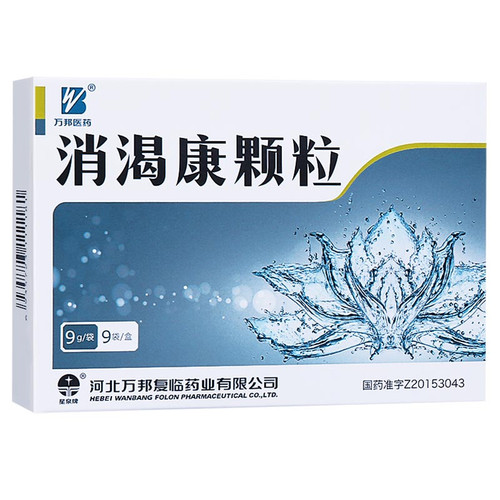Product Overview
Generic name: Xiaoke pills
Chinese Pinyin: Xiaoke Wan
Product name: Baiyun Mountain
Ingredients: Pueraria lobata, Rehmannia glutinosa, Astragalus, Trichosanthes, corn silk, schisandra, yam, glibenclamide.
Properties: This product is a black coated concentrated water pill; it is sweet, sour and slightly astringent.
Functions and indications: Nourish kidney and yin, nourish qi and promote fluid. Used for qi and yin deficiency type diabetes (non-insulin-dependent diabetes), symptoms: polydipsia, polyuria, polyphagia, weight loss, fatigue, poor sleep, low back pain; type 2 diabetes see the above symptoms.
Specification: 0.25g*120 pills/box
Usage and dosage: Orally, 5-10 pills once, 2-3 times a day. Or follow the doctor's advice.
Adverse reactions: The main reports in the literature are: (1) Hypoglycemia, which is induced by delayed meals, strenuous physical activity, or excessive drug doses, and combined use of some drugs that can increase the occurrence of hypoglycemia (see [Precautions]). After hypoglycemia, eating and drinking sugar water can usually be relieved. In the liver and kidney dysfunction, the elderly and infirm, if the dose is too large (the general dose for adult patients may be excessive for the elderly and infirm), it can cause severe hypoglycemia. (2) Occasionally a drug eruption. (3) Occasionally, mild nausea, vomiting and other gastrointestinal reactions are observed. (4) Hair loss is rare.
Contraindications: 1. Pregnant women and breastfeeding women should not take it. 2. Patients with type I diabetes and type 2 diabetes with ketoacidosis, coma, severe burns, infections, severe trauma and major operations are prohibited. 3. People with liver and kidney dysfunction, those who are allergic to sulfa drugs, and those with leukopenia are prohibited.
Note: This product is a Chinese and Western compound preparation. In view of insufficient clinical research data to prove that this compound preparation can reduce or eliminate the adverse reactions of the chemical drugs or other matters that should be noted, the relevant content related to the chemical drugs is listed below. , To remind doctors and patients to pay attention when using this product. 1. The dosage of this product should be gradually increased from 5 pills each time according to the condition. The dosage should be no more than 10 pills each time and no more than 30 pills per day; when the curative effect is satisfactory, the dosage per dosage or the frequency of taking can be reduced gradually to the maintenance dose twice a day. When taking it twice a day, it should be taken once before breakfast and lunch, and try not to take it before dinner. Please control the dosage under the guidance of a doctor. 2. Diabetic patients over 65 years old are poorly tolerant of hypoglycemia and should pay close attention to avoiding hypoglycemic reactions when administering such diabetic patients. The blood glucose control standard is slightly wider than that of ordinary people, fasting blood glucose <7.8mmol/L (140mg/dl), and blood glucose 2 hours after meal <11.1mmol/L (200mg/dl). 3. This product should not be combined with other sulfa drugs. 4. The combination of this product and the following drugs can increase the occurrence of hypoglycemia: (1) Inhibit the excretion of sulfonylurea drugs from the urine, such as probenecid and allopurinol for the treatment of gout; (2) Delay sulfonylurea drugs Metabolism, such as alcohol, H2 receptor blockers (cimetidine, ranitidine), chloramphenicol, antifungal miconazole, anticoagulant. Taking sulfonylureas and alcohol together can cause abdominal pain, nausea, vomiting, headache and facial flushing (especially when chlorpropamide is used). When combined with coumarin anticoagulants, the plasma concentrations of both will increase at first. Since the plasma concentration of both will decrease in the future, the dosage of the two drugs should be adjusted according to the situation; (3) Promote the separation of sulfonylureas that bind to plasma albumin, such as salicylates and fibrates; (4) The drug itself has hypoglycemic effect: alcohol, salicylic acid, guanethidine, monoamine oxidase inhibitor, quinidine; (5) Combine other blood sugar lowering drugs: insulin, metformin, acarbose, insulin sensitizer; (6) β-adrenergic receptor blockers can interfere with the body's blood glucose response during hypoglycemia, hinder liver glycolysis, and at the same time cover up the alert symptoms of hypoglycemia. 5. Combination of this product with the following drugs can increase the occurrence of hyperglycemia: (1) glucocorticoids, estrogen, thiazide diuretics, phenytoin, rifampicin; (2) β-adrenergic blockers can Antagonize the insulin secretion effect of sulfonylureas, so it can also cause hyperglycemia. 6. During medication, blood glucose, urine sugar, urine ketone bodies, urine protein, liver and kidney function, blood picture should be checked regularly, and eye examination should be performed. 7. Use with caution for those with weak constitution, high fever, nausea and vomiting, hypofunction of adrenal cortex or hypofunction of anterior pituitary gland. 8. When symptoms of hypoglycemia occur, the following measures can be taken; (1) Glucose supplement: oral glucose should be taken immediately for mild cases, sweet fruit juice and sugar water can be given by mouth if there is no glucose; for severe cases, glucose can be injected intravenously. Observe that the patient's consciousness is restored. (2) Glucagon treatment: glucagon is injected subcutaneously, intramuscularly or intravenously. Due to its short action time and recurrence of hypoglycemia, it is necessary to supplement glucose or eat after the injection, and continue to observe to ensure The patient is completely out of danger.
Drug interactions: Drug interactions may occur if used with other drugs at the same time. Please consult your physician or pharmacist for details.
Pharmacology and Toxicology: Unclear
Storage: sealed.
Packaging: Plastic bottle packaging, 30 grams (120 pills) per bottle, 1 bottle per box.
Validity period: 36 months
Executive standard: Chinese Pharmacopoeia 2010 Edition One
Approval number: National Medicine Standard Z44020045
Company Name: Guangzhou Baiyunshan Zhongyi Pharmaceutical Co., Ltd.
Company Address: No. 32, Yunpu 1st Road, Luogang District, Guangzhou










